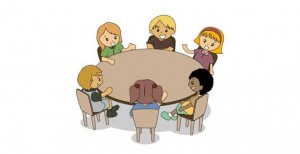Restorative Education
Transforming Our Troubled Schools — and Society
by Robert C. Koehler
What happened?
Can the world shift on such a simple question? Imagine yourself sitting eye-to-eye with a kid in trouble and that’s the first thing you ask. No lecture, no sarcasm, no judgment, no explosion of lost patience and a cry of “Why did you do that?†Just: What happened?
 And then you wait for an answer. When it comes, however haltingly, you press gently and firmly on, still without judgment, just the need to know:
And then you wait for an answer. When it comes, however haltingly, you press gently and firmly on, still without judgment, just the need to know:
What were you thinking at the time?
What have you thought about since?
What do you think you need to do to make things right?
These are the four basic questions of restorative practices, a movement slowly transforming troubled schools and troubled communities around the globe — a movement replacing zero tolerance and other punishment-based and wildly ineffective practices that increase people’s feelings of separation and alienation from one another.
“I found myself running down the hall all the time because of fights,†Rhonda Richetta told me, speaking of her early days as principal of Baltimore’s City Springs School, a K-8 school in a tough inner-city neighborhood. “I would look at kids’ faces. Everyone looked angry, like they didn’t want to be here — adults and children both.â€
In poverty-wracked neighborhoods, this is the American school system. “Education†takes place in a context of anger, violence, intimidation and arrest. The kids are struggling not to learn but “just to survive,†as Ted Wachtel, founder and director of the Bethlehem, Pa.-based International Institute for Restorative Practices, put it.
“How as a society can we live with that?â€
At City Springs, one of four charter schools run by the Baltimore Curriculum Project, Richetta had no intention of living with the situation she had just walked into. This was in 2007. In her quest to change the environment of her school, she learned about IIRP and took training in restorative practices, an extensive philosophy of community-building based on respect, listening and truth-telling rather than punishment. Unlike traditional methods of keeping order in troubled schools, restorative practices require everyone’s full participation, not merely their obedience. It’s a philosophy of “high limit-setting and high encouragement,†Wachtel said.
And Richetta was positive it would work at City Springs. Five years later, with her vision firmly in place, the effectiveness of restorative practices is obvious. I spent half a day at City Springs recently, as part of my own determination to see how people are creating peace on our planet. I sat in “proactive circles†with first-graders and eighth-graders, listening and participating as the kids checked in and talked about how they were doing that day. One teacher said the proactive circle, held not in response to a problem but simply to get the day started, was like taking a daily vitamin. Kids and adults connect with each other and a context of respect and mutual cooperation is established anew.
What I was part of that morning was the result of five years of painstaking effort, on the part of Richetta and others at the school, to apply restorative practices in every situation: five years of patience, listening and asking “what happened?†This question “jolts the kid,†Richetta noted. Suddenly the boy or girl who has gotten into trouble realizes, “Oh, she wants to hear my side†— and begins talking, and becomes part of the solution, not the problem.
When such a program is in place, it seems like common sense itself. But five years ago, Richetta explained, she faced enormous resistance — not from the kids, who hungered to tell their truth, but from the teachers. Many of them couldn’t believe talking and circle work would be supplanting suspensions. Lots of them left. But she held her ground.
One story she told me illustrates the depth of the change at City Springs. At Perkins Homes, the nearby public housing development where most of the students live, two groups of boys from different courtyards developed an intense, violent rivalry, and daily fighting was the norm. The assistant principal at the time was adamant that the animosity among the boys would overwhelm any circle process and the two groups had to be kept separated. The school put a lot of energy into doing so, but things eventually erupted anyway.
“Finally I said, I don’t care what anybody says, we’re putting them all in a circle,†Richetta said. The idea of a conflict circle is to get enemies to listen to one another, no easy task, and “at first it didn’t go well. We had to keep pulling disruptive kids out.â€
But eventually the two sides began talking and “what started to come out of the whole conversation was how ridiculous it was. They were fighting over nothing — it was amazing to me to sit there and hear them. This is so ridiculous. These boys were fighting and wanting to kill each other over nothing!â€
And gradually this awareness dawned on all the participants. Finally one of the principle ringleaders stood up and shook a rival’s hand, and others followed suit. “These kids became friends at school,†Richetta said, “but when they went into the neighborhood they had to pretend they were enemies.â€
And this is why the peace-building process has no boundaries. “The word about restorative practices should be spread around the world,†Richetta said. “I’m grateful for what it has done to transform this school. What if we could transform this community, this city, the whole nation?â€
Robert C. Koehler is an award-winning, Chicago-based journalist and nationally syndicated writer. His new book, Courage Grows Strong at the Wound is now available. Contact him at koehlercw@gmail.com or visit his website at commonwonders.com.

And the next step is to gather the ‘conflict circles’ into ‘talking circles’ and ask ‘what do we want to learn today?’ and ‘how do we want to learn today?’
1